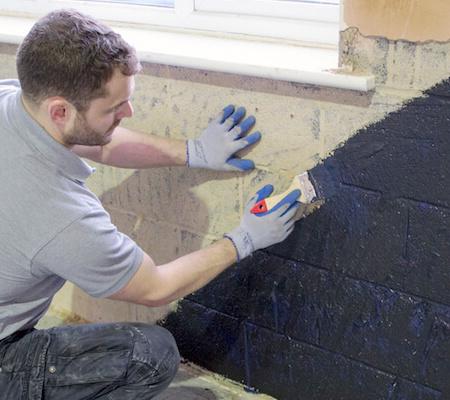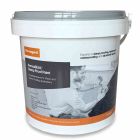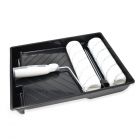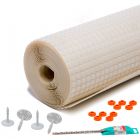Help & Advice Articles, Videos and How-to-Guides
Filter Articles

Does damp proof paint really work?
Is your property suffering from damp and ugly mould patches? Well, you’re not alone. Damp is one of the most common problems suffered by properties in the UK. Like you, many homeowners are looking for a long-lasting solution. Damp proof paint is positioned as one such solution, but does it really work? Here at Permagard, we provide the insights you need to answer that question.
What is damp proof paint?
Damp proof paint is specifically formulated for treating interior wall surfaces and can be easily applied and maintained. It can be used on walls, floors and ceilings, forming an impermeable barrier against water. This makes it an effective solution for preventing damp growth.
Not all products in this space are of the same quality, so it’s worth doing your research. PermaSEAL Damp Proof Paint is reliable and hassle-free, ensuring long-lasting protection against damp issues in your home.
How does it work?
Damp proof paint is a styrene butadiene (SBR) based paint. Once applied to a wall, it forms a membrane that prevents water and damp from seeping through to the surface. By creating an impermeable barrier, damp proof paint protects against penetrating damp in walls and ceilings. Our PermaSEAL Damp Proof Paint can also be used as a damp proof membrane for floors in some cases.
However, you should note that damp proof point is not a fix for existing damp. You must first identify the root cause and resolve it. Once the issue has been fixed, it’s time to make sure that the surface is free of patches, old flacking paint or mould. Applied correctly, this paint prevents it from coming back.
Damp proof paint vs anti mould paint
When researching various damp proofing paints, you may have come across anti-mould paint. This is a different product and not to be confused. Damp proof paint is designed to prevent moisture from seeping through walls to the surface, usually applied in areas like bathrooms and garages. Anti mould paint, on the other hand, stops mould growth.
While they are linked, damp and mould are different things. Damp is excessive moisture in your home, causing damp patches and occasionally tidemarks, whereas mould is a fungus that grows in these damp conditions. You can read our jargon buster here.
Our PermaPROTECT Anti Mould Paint is formulated with advanced biocides that tackle mould spores and provide five years of guaranteed protection. You can learn more about our anti mould paint here.
How it can help
Damp proof paint is a quick and simple solution to many damp issues. It’s a flexible product that can be washed, wiped and painted over, providing a strong, reliable barrier for years to come.
Reduce the risk of damp problems
Damp proof paint can reduce the risk of damp resurfacing. Homes in wet climates are more prone to damp problems. Therefore, damp proof paint acts as a barrier against water ingress.
Easy to maintain
Although more advanced than ordinary wall paint, damp proof paint is still easy to apply and maintain. Once fully cured, the final surface can be washed or wiped like any regular wall.
Save money
Damp proof paint contains a powerful polymer that protects against damp for longer. Without the need for more regular re-application, you cut down on costs significantly.
Make home appealing
Damp proof paint is used to make rooms suffering from damp look brighter and fresher. More importantly, they will actually be free of damp. If you are selling or planning to rent your property, make sure that any damp problems are treated professionally. A potential buyer or tenant will be instantly put off if damp is visible.
When to use damp proof paint
As we mentioned earlier, damp proof paint should only be used to protect against damp. If the surface you’re planning to paint is already suffering from damp, then you first need to fix the underlying cause, where possible. It will not be able to fix plumbing issues or another building fault.
Damp proof paint works particularly well when it’s sandwiched between fabric layers. For example, when it’s applied before a render, between the render and plaster, or before tiling. It’s also great underneath a self-levelling compound on the floor. This stops damp getting through to your finishes but also protects the damp proof paint itself, increasing its lifespan.
If using in kitchens and bathrooms, it’s vitally important that the humidity levels are controlled first with adequate ventilation.
Other applications include:
- Interior paint for a variety of surfaces to prevent penetrating damp
- As a damp proof membrane for floors
- Externally behind render as extra protection
- Under render to help prevent water ingress from seeping through
For more uses, check out our damp proof paint product page.
How long does damp proof paint last?
If the substrate is well prepared and the damp proof paint is applied to a surface with no standing water, and in temperatures between 10-25 degree Celsius, the barrier can last for a long time if it’s not physically disturbed. If these conditions are followed, then you’re left with a high-performance, long-lasting damp barrier in just 2 coats, that can last for 20+ years.
Read our guide to applying damp proof paint.
Treating the cause
Damp can be the result of a range of issues, so knowing more about the types will help ensure you treat it effectively.
- Penetrating damp - this type of damp occurs when water from outside has found its way into your home. It’s usually caused by building or plumbing faults, such as leaky pipes, faulty render or missing roof tiles. It can cause structural issues if left untreated.
- Rising damp - rising damp is the result of groundwater entering your home via capillary action. This could be the result of a missing or bridged damp proof course (DPC).
- Condensation - excess moisture in the air and poor ventilation can cause damp issues.
Read our guide on the causes of damp to identify the type of damp you’re seeing, and how to remove it for good.
Permaseal Damp Proof Paint
Permagard’s PermaSEAL Damp Proof Paint can be used on numerous surfaces for damp proofing and vapour proofing applications.
Our damp proof paint is a high-performing liquid, ready to use straight from the bucket. The paint’s consistency is similar to thick emulsion paint, boasting several properties including flexibility and resistance to UV light.
Damp proof paint can be applied simply by brush, roller or spray and can dry within one hour of the application. The paint dries to a semi-gloss finish and can be painted over with ordinary emulsion paints.
PermaSEAL Damp Proof Paint can be used to treat a variety of damp proof problems. It can be used under a render as a waterproof layer when damp proofing walls, or over plaster for vapour proofing. Aside from this, the reliable paint can be used as part of a basement waterproofing system.
Other benefits:
- Tough, flexible and elastic
- Non toxic, non hazardous, solvent and plasticiser free
- Quick drying
- Low water vapour permeability
- Can be applied to alkaline surfaces
- Resistant to silage acids
- Non staining, non blocking
- User-friendly
So, does damp proof paint really work?
With the right technique and the right brand, yes, damp proof paint can really protect your home against damp. Just remember that ordinary paint will not treat damp or mould problems. It is also important to note that damp proof paint will not work if your property is suffering from structural damage caused by damp.
For more details on our PermaSEAL Damp Proof Paint, PermaPROTECT Anti Mould Paint or any other of our damp proofing products, call us on 0117 982 3282.



